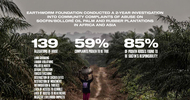Olam | 15 November 2010

Olam International Limited a leading global, integrated supply chain manager and processor of agricultural products and food ingredients, today announced that the Company has entered into a Joint Venture Agreement ('JV') with the government of the Republic of Gabon ('RoG') to initially develop in Phase I, 50,000 hectares of palm plantation in Gabon with an investment of US$236 million. Olam will hold 70% interest in the joint venture company to be set up, and the remaining 30% will be held by RoG.
As part of the agreement, RoG has committed to the JV a land bank of 300,000 hectares for palm and rubber plantation development in multiple phases, of which 50,000 hectares will be developed in Phase I of the project.
The President of Gabon, His Excellency Ali Bongo Ondimba, who was in Singapore on a State visit said: "We are excited about the prospects of partnering Olam, one of the world’s leading agri-commodity companies. Together, we will build a highly competitive integrated palm industry in Gabon which has the potential to rank amongst the most competitive palm oil producers in the world. Our country is an attractive location for foreign investments in industries beyond the Oil & Gas sectors and we welcome Olam investing jointly with us to help diversify our economy and achieve our country’s full economic potential."
Concurring, Olam’s Group Managing Director and CEO Sunny Verghese said: "As outlined in 2009, one of the key thrusts of our strategy is to selectively integrate upstream into plantations in countries that have a long term sustainable comparative advantage to produce agricultural raw materials cheaper or better. In palm, we believe that Gabon can be a very cost competitive producer given its soil and agro-climatic conditions that are very suitable for palm cultivation. In addition, securing an attractive land bank of 300,000 hectares would allow us to profitably expand our palm and rubber plantation businesses going forward."
The project will also enjoy other incentives, including income tax holiday for 16 years starting from FY2011, exemption from VAT and custom duties on imported machinery and inputs, Oil & Gas and fertilisers.
Planting is expected to commence in early 2012 and be completed by 2016. The plantation is expected to achieve peak yields of up to 26 metric tonnes of fresh fruit bunches (FFB) per hectare. The investment includes setting up milling plants to extract crude palm oil (CPO), which will be sold in Africa and exported to the EU. The project is expected to achieve 100% Roundtable on Sustainable Palm Oil 1(‘RSPO’) certification and therefore have a unique value proposition for the markets.
Investment Rationale and Strategic Fit
Palm is the largest and fastest growing vegetable oil with multiple end uses. Origins like Africa have an increasingly larger role to play alongside established supply bases like Indonesia and Malaysia as the industry needs to ramp up production to cater to growing demand.
In its 2009 corporate strategy, Olam had articulated the intent of "pursuing select, scalable and attractive opportunities upstream" and in particular scaling up its "West Africa palm presence". The proposed investment in palm in Gabon is therefore, ‘On-Strategy and On-Plan’. This joint venture is Olam’s second African palm investment after its first investment in this space through Nauvu Investments, a joint venture in palm plantation, milling and refining in Cote d’Ivoire and rubber plantations in Cote d’Ivoire, Ghana and Nigeria.
The palm investment opportunity in Gabon satisfies all key success factors for upstream participation in palm plantations with good potential for excess returns. These include:
1. Land availability and suitability: Access to 300,000 hectares of sizeable, contiguous land in suitable agro-climatic conditions (soil and rainfall) for growing palm, with minimal threat from local community or land rights issues. The soil conditions and the rainfall pattern are capable of yielding up to 26 metric tonnes of FFB per hectare. Given that palm can only be grown within 6 to 8 degrees of the equator, and large tracts of land suitable for greenfield palm development in the traditional growing regions are becoming increasingly scarce, Olam’s access to prime land in suitable soil and agro-climatic condition in Gabon is very valuable.
2. Cost competitiveness: The project is expected to be competitive factoring in development and operating costs as well as freight advantages to the destination markets of Africa and Europe. In addition, Gabon is expected to enjoy less inflationary pressures compared to Southeast Asian palm producing nations. The project will also benefit from government incentives on taxes and duties given Gabon’s efforts to promote palm as a key lever of economic development. Olam will also benefit from synergies in overheads through existing presence in Gabon and other upstream investments.
3. Environmental sustainability: The Gabon palm project is envisaged to be fully RSPO compliant. This would provide superior market access, especially in the EU, as more and more major end users are demanding RSPO compliant oil. This advantage is especially salient as just approximately 7% of global CPO production is currently certified RSPO compliant.
4. Plantation management expertise: Olam has accumulated internal expertise in managing upstream plantation and farming activities through its various investments including almonds, coffee, cotton and peanuts. Specific to this investment, Olam is assembling a world-class palm team and is being advised by renowned industry experts.
Financial Impact
The total investment of US$236 million will be largely phased across a seven-year period and financed through a Debt:Equity Ratio of between 1:1 and 1.5:1. Olam’s 70% share of the equity investment is expected to be around US$83 million.
The returns from this project are expected to exceed Olam’s threshold for an investment of this nature. The project is expected to achieve an EBITDA of US$$100-120 million or an EBITDA margin of 50-60% at peak productivity. An Equity IRR in the range of 24-29% and average ROE of 35-40% is expected from this investment.
This investment is subject to a satisfactory completion of Social and Environmental Impact Assessment (‘SEIA’) and a High Conservancy Value (‘HCV’) study.











